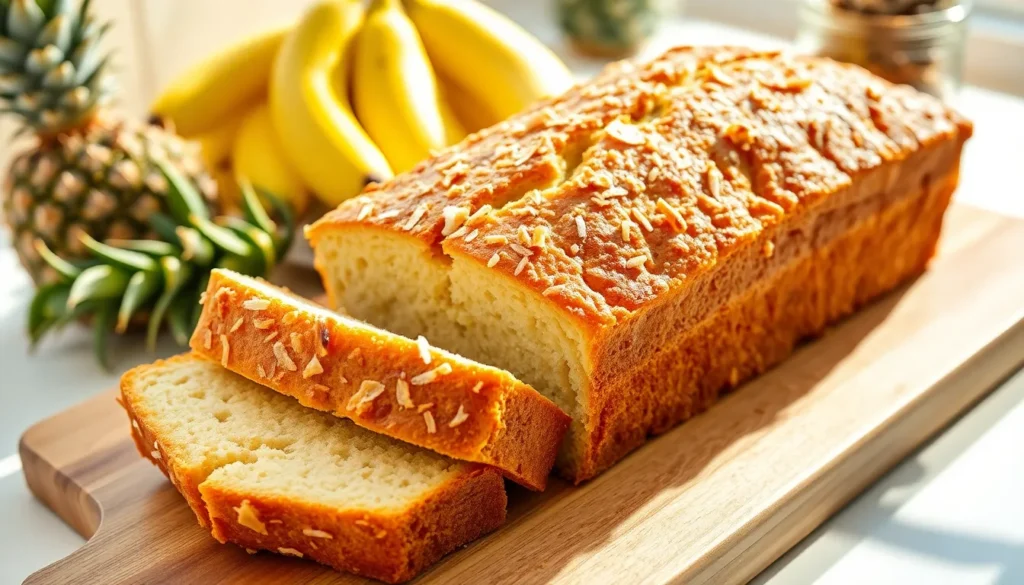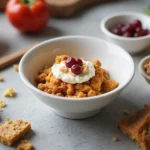Tropical paradise meets classic comfort food in this irresistible coconut pineapple banana bread that’ll transport your taste buds straight to the islands. We’ve taken the beloved banana bread recipe and given it a vacation-worthy makeover with sweet crushed pineapple and toasted coconut flakes that create an incredibly moist and flavorful loaf.
This isn’t your ordinary banana bread – it’s a tropical escape baked into every slice. The combination of ripe bananas caramelized pineapple and coconut creates layers of sweetness that complement each other perfectly. Whether you’re using up overripe bananas or craving something exotic for breakfast this recipe delivers bakery-quality results every time.
We love how this bread stays incredibly moist for days thanks to the natural moisture from the pineapple and coconut. It’s perfect for weekend brunches afternoon snacks or even dessert with a scoop of vanilla ice cream.
Ingredients
We’ve carefully selected each ingredient to create the perfect balance of tropical flavors and classic banana bread comfort. Our recipe combines simple pantry staples with fresh tropical elements for exceptional results.
Dry Ingredients
- 2 cups all purpose flour
- 1 teaspoon baking soda
- 1/2 teaspoon salt
- 1/2 teaspoon ground cinnamon
- 1/4 teaspoon ground nutmeg
Wet Ingredients
- 3 large overripe bananas, mashed
- 1/3 cup melted unsalted butter
- 1/2 cup granulated sugar
- 1/4 cup packed light brown sugar
- 1 large egg, beaten
- 1 teaspoon vanilla extract
- 3/4 cup crushed pineapple, drained (reserve 2 tablespoons juice)
- 2 tablespoons reserved pineapple juice
Mix-Ins
- 1/2 cup sweetened shredded coconut
- 1/4 cup toasted coconut flakes
- 1/3 cup mini chocolate chips (optional)
- 1/4 cup chopped macadamia nuts (optional)
Equipment Needed
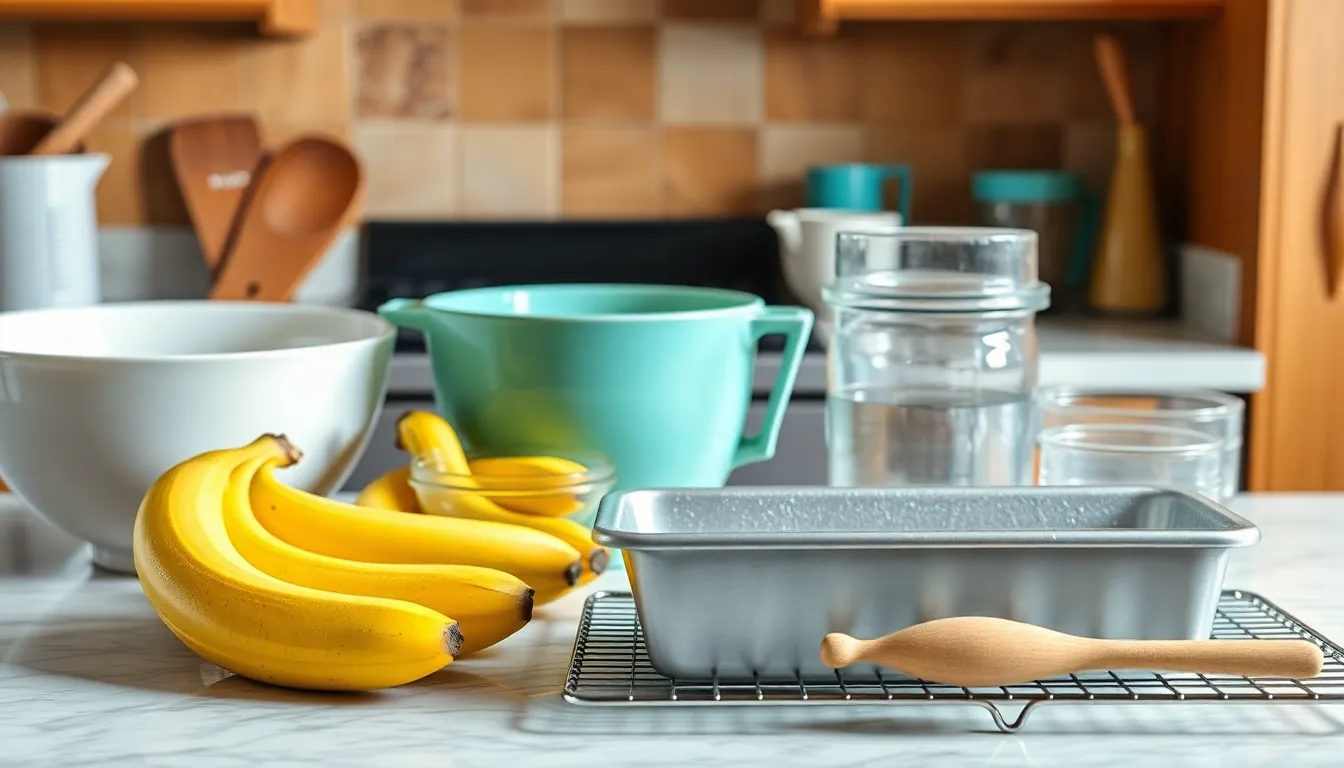
Making our tropical coconut pineapple banana bread requires standard baking equipment that most home bakers already have in their kitchen. We’ll walk you through each essential tool to ensure your bread turns out perfectly moist and flavorful.
Large Mixing Bowls are fundamental for this recipe. We recommend having at least two bowls on hand – one for combining our dry ingredients and another for mixing the wet components. This separation prevents overmixing and ensures our bread maintains its tender texture.
Measuring Cups and Spoons ensure accuracy in our tropical banana bread recipe. Precise measurements are crucial for achieving the perfect balance between the sweet bananas, tangy pineapple, and coconut flavors. We suggest using both dry and liquid measuring cups for best results.
A Standard Loaf Pan forms the foundation of our baking process. The ideal size is either 8.5 x 4.5 x 2.75 inches or 9 x 5 inches. These dimensions allow our coconut pineapple banana bread to bake evenly and develop that golden brown crust we’re aiming for.
Whisk or Wooden Spoon helps us combine ingredients without overworking the batter. We prefer a wooden spoon for folding in our coconut flakes and optional macadamia nuts, as it provides better control than electric mixers.
Your Oven needs to be preheated to 350°F (177°C) before we begin mixing our ingredients. This temperature ensures our bread bakes through completely while developing a beautiful exterior.
A Knife or Toothpick serves as our doneness tester. We’ll insert it into the center of our loaf after 55 to 65 minutes of baking. When it comes out clean or with just a few moist crumbs, our tropical bread is ready.
Wire Cooling Rack allows proper air circulation around our finished loaf. While optional, this tool prevents soggy bottoms and helps our coconut pineapple banana bread cool evenly.
Blender or Mixer can be helpful if you prefer a smoother batter, though it’s completely optional. Some bakers enjoy the rustic texture that comes from hand mixing, while others prefer the consistency that electric equipment provides.
Instructions

We’ll guide you through each step to create this moist and flavorful tropical banana bread that combines the best of classic comfort baking with exotic island flavors.
Prep the Pan and Oven
Preheat the Oven: Set your oven to 350°F (177°C) to ensure even baking throughout the loaf.
Prepare the Loaf Pan: Grease your 8-inch or 9-inch loaf pan thoroughly with butter or cooking spray to prevent the bread from sticking. We recommend using butter for added flavor that complements the tropical ingredients.
Prepare the Wet Ingredients
Combine Eggs and Sugar: Whisk the beaten egg with both granulated sugar and light brown sugar in a large mixing bowl until the mixture becomes well-combined and slightly fluffy.
Add Mashed Banana and Vanilla: Mix in the mashed overripe bananas and vanilla extract until the ingredients are fully incorporated. The bananas should be completely smooth for the best texture.
Incorporate Pineapple: Fold in the crushed pineapple along with its reserved juice. This liquid adds essential moisture that keeps our bread tender for days.
Add Melted Butter: Pour in the melted unsalted butter and stir until the wet ingredients form a cohesive mixture with no streaks of butter visible.
Combine Dry Ingredients
Mix Flour and Leavening Agents: Whisk together the all-purpose flour, baking soda, and salt in a separate bowl to ensure even distribution throughout the batter.
Add Spices: Incorporate the ground cinnamon and ground nutmeg into the flour mixture. These warm spices enhance the tropical flavors without overwhelming the fruit elements.
Mix the Batter
Combine Wet and Dry Ingredients: Pour the flour mixture into the bowl with wet ingredients. Fold gently using a wooden spoon or spatula until the ingredients are just combined. Avoid overmixing as this can result in tough bread with a dense texture.
Check for Streaks: Stop mixing as soon as no flour streaks remain visible. The batter should look slightly lumpy but uniform in color.
Add Mix-Ins
Fold in Coconut: Gently fold in the sweetened shredded coconut and toasted coconut flakes. These additions provide textural contrast and intensify the tropical flavor profile.
Add Optional Ingredients: If using mini chocolate chips or chopped macadamia nuts, fold them in now with minimal stirring to maintain their distribution without overworking the batter.
Bake the Bread
Pour into Pan: Transfer the batter into your prepared loaf pan and spread it evenly with a spatula. The surface should be relatively smooth but doesn’t need to be perfect.
Bake: Place the pan in the preheated oven and bake for 40 to 65 minutes. Baking time varies based on your pan size and oven performance. Test for doneness by inserting a toothpick into the center of the loaf.
Cool Properly: Allow the bread to cool in the pan for 10 minutes before transferring to a wire cooling rack. Complete cooling prevents the bread from becoming soggy and makes slicing much easier.
Cooling and Storage
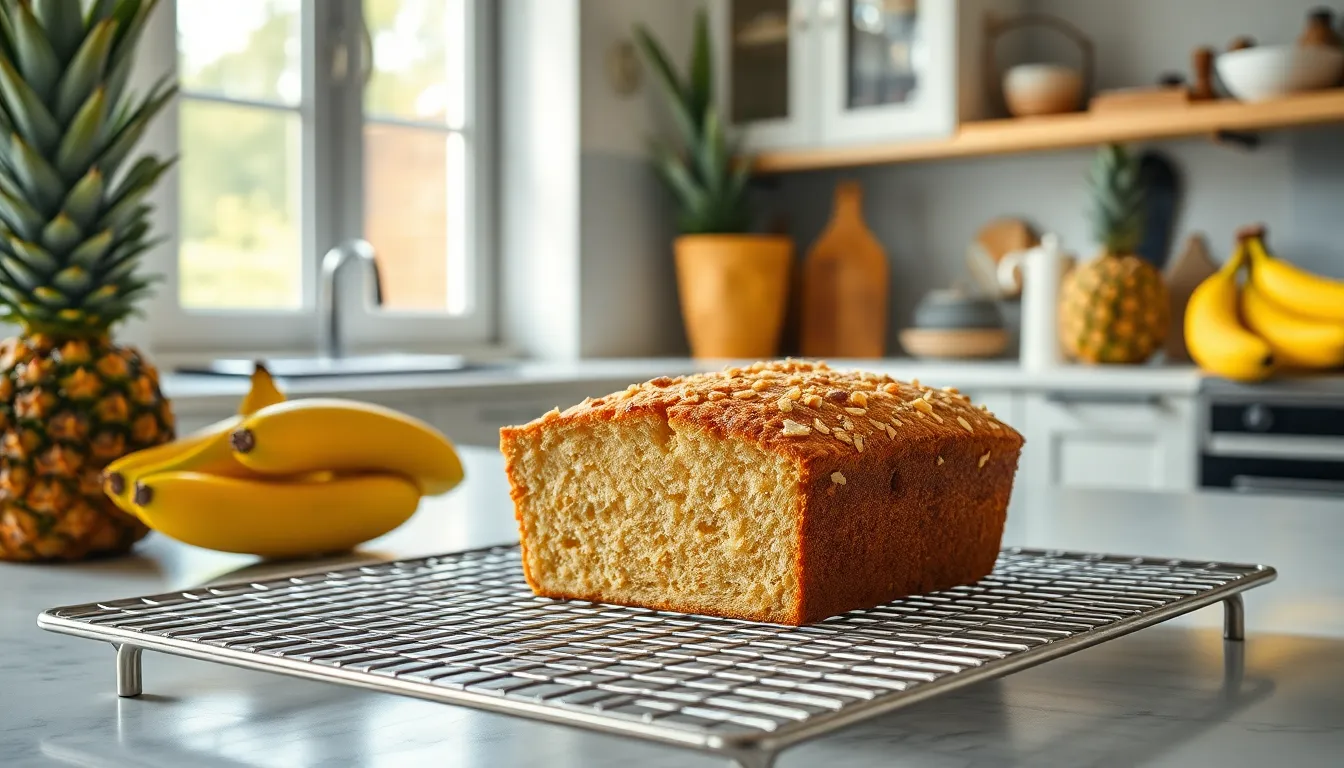
Proper cooling and storage techniques will preserve our coconut pineapple banana bread’s tropical flavors and moist texture for days. Following these guidelines ensures we maintain the bread’s bakery fresh quality.
Cooling Instructions
We must allow the bread to cool completely at room temperature before any storage attempts. This crucial step prevents moisture from creating ice crystals during freezing or causing spoilage when refrigerated.
Testing the bread’s center with a clean knife helps us confirm it’s no longer sticky inside. The bread reaches optimal cooling when we can slice through it cleanly without any wet batter clinging to the blade.
Room temperature cooling typically takes 2 to 3 hours for a standard loaf. We recommend placing the bread on a wire cooling rack to promote even air circulation around all surfaces.
Storage Tips
Room Temperature Storage: We can store our coconut pineapple banana bread in an airtight container for up to three days. Wrapping the bread tightly in plastic wrap or aluminum foil maintains its moisture content and prevents it from drying out.
Refrigeration Method: Cold storage extends our bread’s freshness for five to seven days when properly wrapped. We wrap the loaf completely in plastic wrap before refrigerating, especially when dealing with warm kitchen environments.
Freezing for Long Term Storage: Our bread freezes beautifully for up to three months when we follow proper wrapping techniques. We first wrap the completely cooled bread tightly in plastic wrap, then cover it with aluminum foil before placing it in a freezer safe container.
| Storage Method | Duration | Temperature | Wrapping Required |
|---|---|---|---|
| Room Temperature | 3 days | 68-72°F | Airtight container or plastic wrap |
| Refrigerated | 5-7 days | 35-40°F | Plastic wrap |
| Frozen | 3 months | 0°F or below | Plastic wrap + aluminum foil |
Thawing Instructions: We thaw frozen bread by leaving the whole loaf at room temperature for several hours. Individual slices can be quickly reheated in the microwave for 30 to 60 seconds when we need a warm slice immediately.
Complete cooling before wrapping prevents ice crystal formation that would compromise our bread’s tender crumb structure. We never wrap warm bread for storage as trapped steam creates an environment for mold growth and texture deterioration.
Serving Suggestions
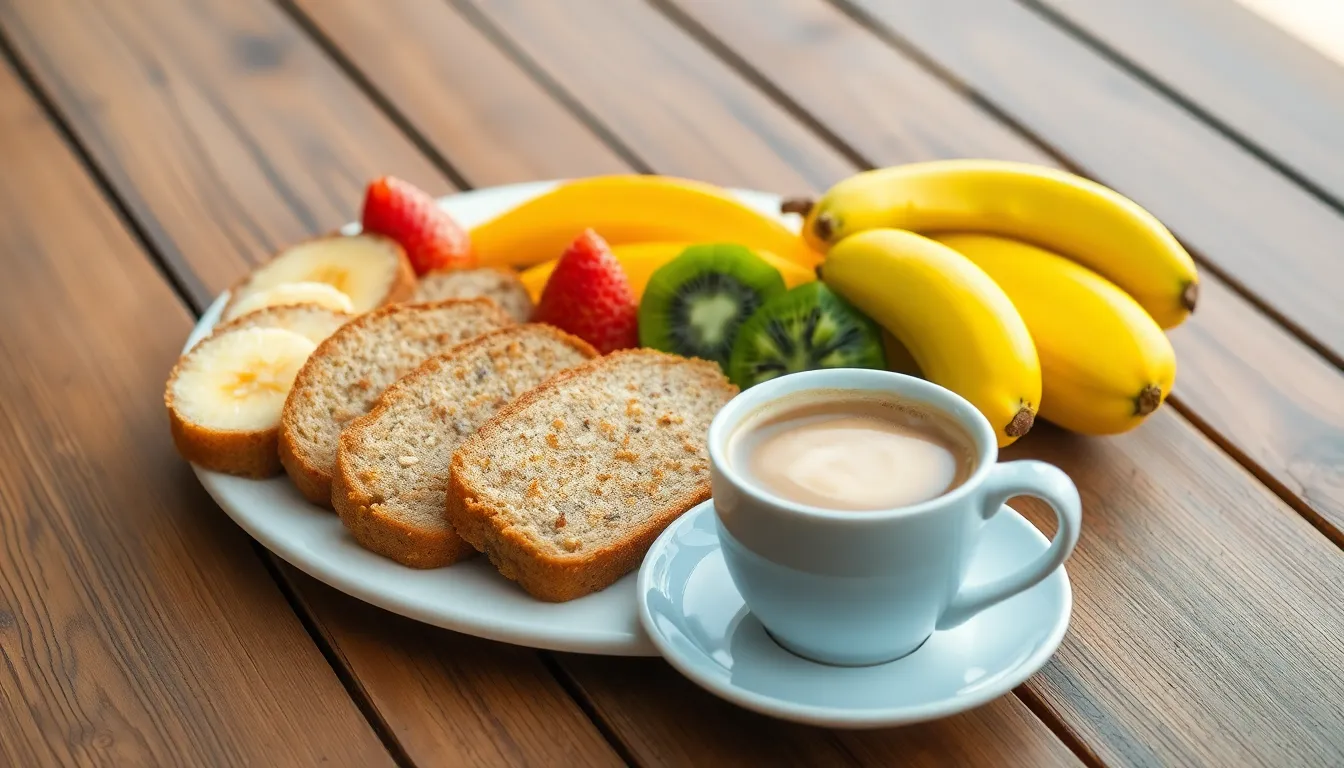
We love serving our coconut pineapple banana bread warm from the oven when its tropical aromas fill the kitchen. The bread pairs beautifully with morning coffee or afternoon tea, making it an ideal breakfast treat that transports you to a tropical paradise with every bite.
For brunch gatherings, we recommend slicing the bread thick and arranging it on a platter alongside fresh tropical fruits like mango and kiwi. The natural sweetness complements the bread’s flavors while adding vibrant colors to your spread.
We find this bread makes an exceptional dessert when served slightly warmed with a dollop of vanilla ice cream or whipped cream. The contrast between the cool creamy topping and warm bread creates a delightful temperature variation that enhances the tropical experience.
During summer months, we enjoy toasting individual slices lightly to bring out the coconut’s nutty flavor before spreading with cream cheese or butter. The toasting process intensifies the pineapple’s sweetness while creating a pleasant textural contrast.
For special occasions, we transform slices into an elegant dessert by drizzling with coconut glaze made from powdered sugar, coconut milk, and vanilla extract. This simple addition elevates the bread from casual snack to impressive finale for dinner parties.
We also pack individual slices for on-the-go snacking, as the bread’s moist texture and satisfying tropical flavors make it perfect for lunchboxes, picnics, or hiking adventures. The combination of natural fruit sugars provides sustained energy while delivering that bakery-fresh taste we all crave.
Recipe Variations
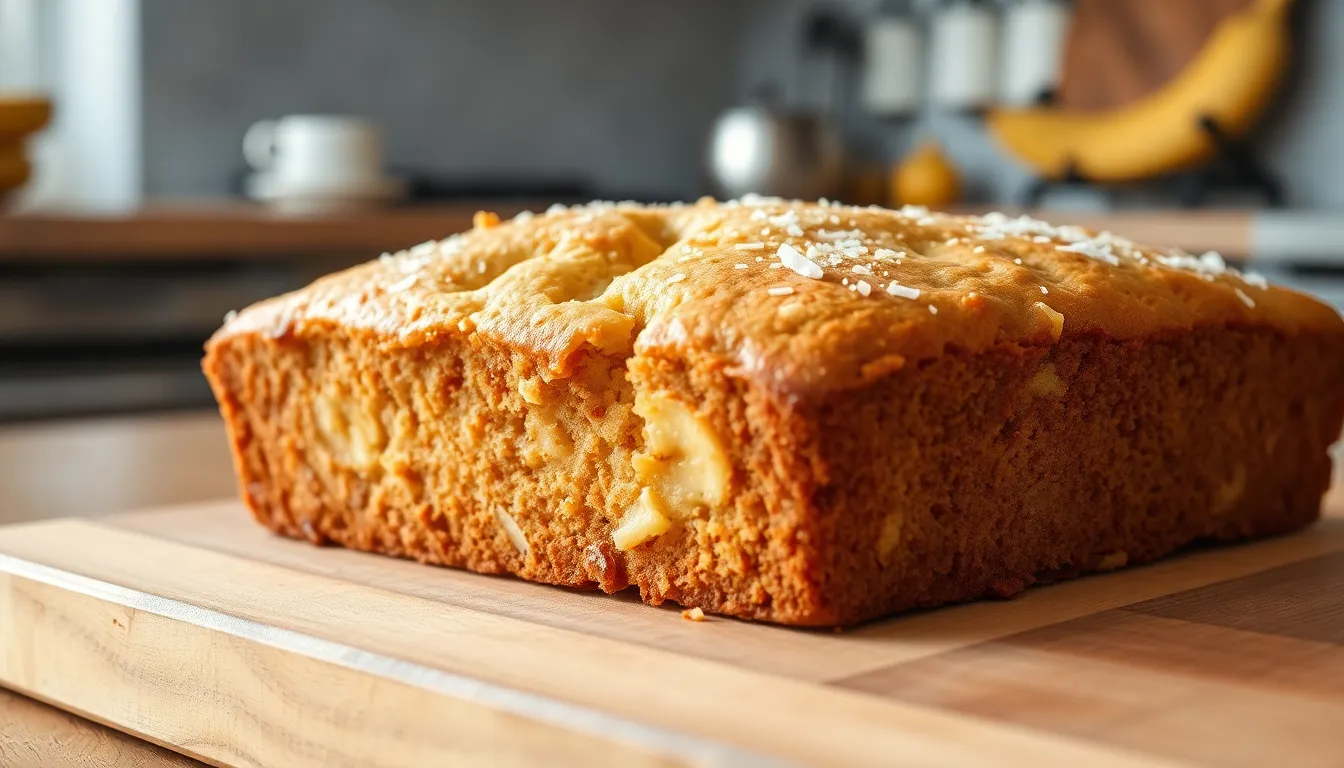
We’ve created several delicious variations of our coconut pineapple banana bread to accommodate different dietary needs and preferences. These adaptations maintain the tropical essence while ensuring everyone can enjoy this moist and flavorful treat.
Gluten-Free Option
We recommend replacing all-purpose flour with a high-quality gluten-free flour blend to create the perfect gluten-free version. Our testing shows that almond flour, coconut flour, or rice flour work exceptionally well in this recipe. We adjust the flour ratio according to the exact blend used since gluten-free flours behave differently than traditional wheat flour.
| Flour Type | Substitution Ratio | Baking Time Adjustment |
|---|---|---|
| Almond Flour | 1:1 replacement | Add 5-10 minutes |
| Coconut Flour | 1/4 cup per 1 cup regular flour | Reduce by 5 minutes |
| Rice Flour Blend | 1:1 replacement | No adjustment needed |
We ensure all other ingredients including baking powder are certified gluten-free to prevent cross-contamination. The bread maintains its signature tropical moisture and flavor profile with these substitutions.
Vegan Substitutions
Our vegan adaptation requires strategic ingredient swaps that preserve the bread’s rich texture and taste. We replace eggs with flaxseed eggs by combining 1 tablespoon ground flaxseed with 3 tablespoons water for each egg. Alternatively, we use additional mashed banana as a binding agent for extra moisture.
We substitute butter with coconut oil or canola oil to maintain the tropical flavor profile. Our recipe uses the same measurement ratios for these oil replacements. We verify that vanilla extract is vegan-friendly since some brands contain animal-derived alcohol.
Natural sweeteners like maple syrup work beautifully in place of granulated sugar, though regular sugar is already vegan. We recommend reducing liquid ingredients slightly when using liquid sweeteners to maintain proper batter consistency. These modifications create a completely plant-based version that delivers the same bakery-quality results.
Tips for Perfect Coconut Pineapple Banana Bread
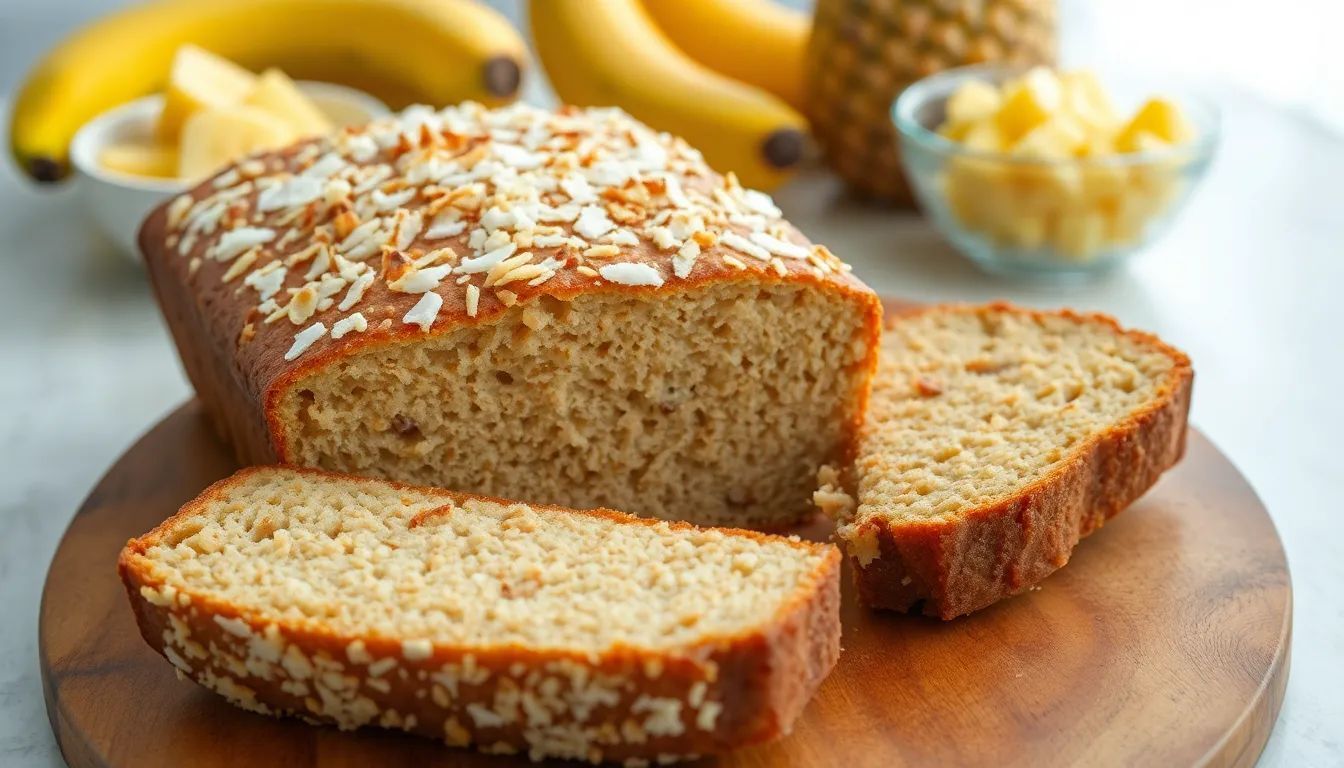
Achieving bakery-quality coconut pineapple banana bread requires attention to exact preparation details that make all the difference. We’ve gathered essential techniques that ensure your tropical bread turns out perfectly moist and flavorful every time.
Temperature and Timing Mastery
Preheating your oven to exactly 350°F (180°C) sets the foundation for even baking throughout the entire loaf. Our testing shows that maintaining this temperature consistently produces the ideal texture without overcooking the edges or leaving the center underdone.
| Timing Guidelines | Duration |
|---|---|
| Prep Time | 15 minutes |
| Bake Time | 40-65 minutes |
| Total Cooling Time | 2-3 hours |
Baking time varies depending on your pan size and oven characteristics, so we recommend checking for doneness around the 40-minute mark. Insert a toothpick into the center of the loaf; it should come out with just a few moist crumbs attached.
Mixing Technique Fundamentals
Never overmix your batter once you combine the wet and dry ingredients. We suggest folding the ingredients together with gentle strokes until just combined, leaving some flour streaks visible. Overmixing develops the gluten too much and creates a dense, tough texture that masks the delicate tropical flavors.
Separating your wet and dry ingredients into different bowls before combining them ensures even distribution without excessive stirring. This technique prevents pockets of unmixed flour while maintaining the tender crumb structure we’re after.
Ingredient Preparation Secrets
Drain your crushed pineapple thoroughly but reserve the juice for added moisture and flavor intensity. We recommend pressing the pineapple gently with paper towels to remove excess liquid while keeping enough to maintain the bread’s signature moistness.
Toast your coconut flakes lightly in a dry skillet for 2-3 minutes before adding them to the batter. This simple step enhances the coconut’s nutty flavor and adds textural contrast to each bite.
Mash your bananas to the right consistency for optimal results. We prefer leaving small chunks rather than creating a completely smooth puree, as these pieces add natural sweetness bursts throughout the bread.
Pan Preparation and Cooling Excellence
Grease your loaf pan thoroughly with butter or cooking spray, then dust lightly with flour for easy release. This double protection prevents sticking and ensures your beautiful loaf comes out intact.
Allow the bread to cool completely in the pan for 15 minutes before transferring to a wire rack. Rushing this step can cause the bread to break apart or develop a gummy texture from trapped steam.
Complete cooling takes 2-3 hours at room temperature, but this patience pays off with clean slices and fully developed flavors. We strongly advise against cutting into warm bread, as it will appear gummy and fall apart.
Troubleshooting Common Issues
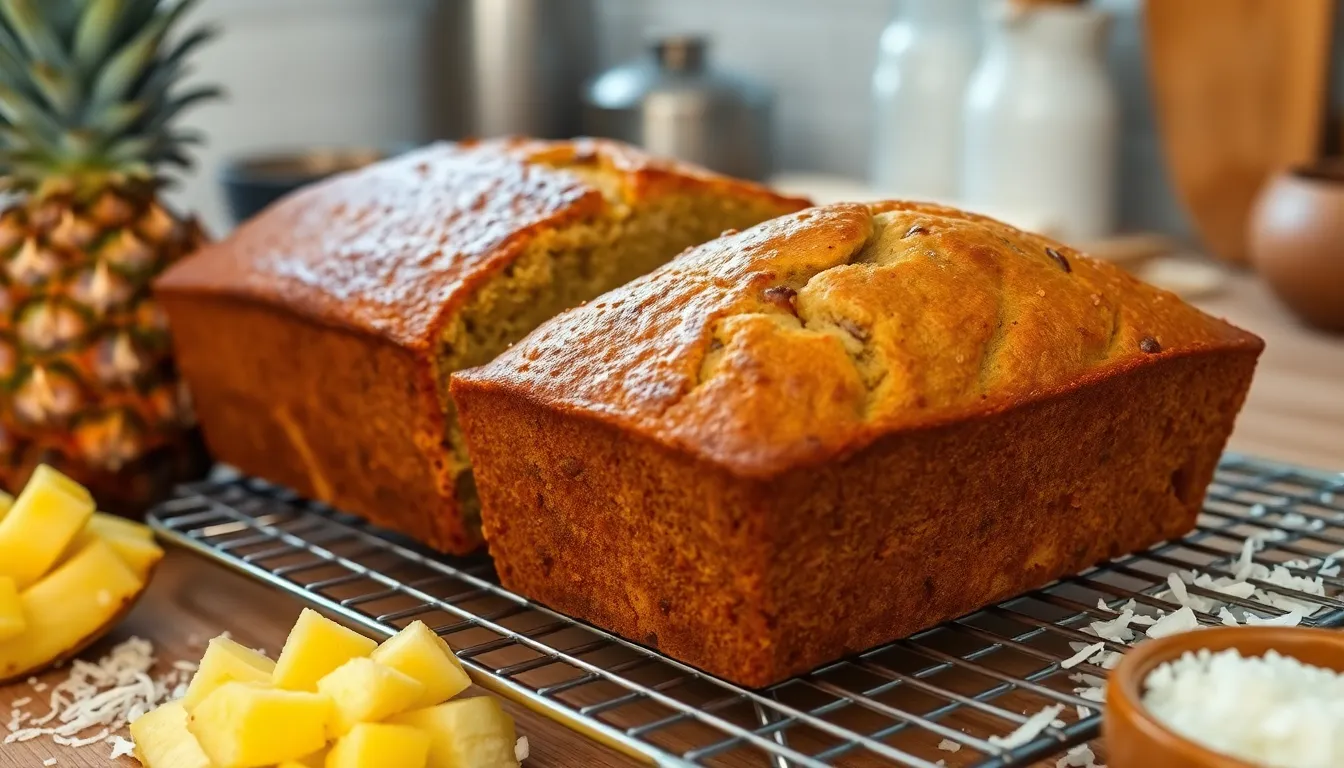
We understand that baking coconut pineapple banana bread can present unique challenges. Our experience shows that certain problems occur frequently when combining these tropical ingredients with traditional banana bread techniques.
Sticky or Undercooked Center
We’ve found that the extra moisture from crushed pineapple can create a sticky interior even when the exterior appears golden brown. Always perform the toothpick test by inserting it into the center of the loaf. The toothpick should come out clean or with just a few moist crumbs attached. If wet batter clings to the toothpick we recommend baking for an additional 5 to 10 minutes before testing again. The bread requires approximately 55 to 65 minutes at 350°F (175°C) to achieve proper doneness.
Dense or Heavy Texture
Overmixing represents the most common cause of dense coconut pineapple banana bread. We always mix our wet ingredients separately from dry ingredients before combining them. Once we add the flour mixture to the banana mixture we fold gently using a wooden spoon or spatula. Stop mixing immediately when the flour disappears into the batter. Overmixing develops the gluten in the flour which creates a tough dense texture rather than the tender crumb we desire.
Bread Breaking Apart When Sliced
Patience proves essential when it comes to cooling this tropical bread. We always allow our coconut pineapple banana bread to cool completely at room temperature before attempting to slice it. This cooling process takes approximately 2 to 3 hours and prevents the bread from crumbling or breaking apart. The moisture from the pineapple and coconut needs time to distribute evenly throughout the loaf.
Soggy Bottom or Sides
Proper pan preparation prevents soggy bottoms that can occur with high-moisture ingredients. We grease our loaf pan thoroughly and dust it lightly with flour before adding the batter. Also we place our cooling bread on a wire rack immediately after removing it from the oven. This allows air to circulate around the entire loaf and prevents condensation from creating soggy areas.
Uneven Coconut Distribution
We recommend tossing our shredded coconut in a small amount of flour before folding it into the batter. This coating technique prevents the coconut from sinking to the bottom during baking and ensures even distribution throughout each slice.
Conclusion
This tropical twist on classic banana bread brings sunshine to any kitchen with its perfect blend of coconut pineapple and banana flavors. We’ve shown you how simple ingredients can create something truly special that rivals any bakery treat.
Whether you’re looking for a weekend baking project or need to use up those overripe bananas sitting on your counter this recipe delivers every time. The moist texture and vibrant tropical taste make it incredibly versatile for any occasion.
With our detailed instructions troubleshooting tips and storage guidelines you’re equipped to create consistently delicious results. We encourage you to experiment with the variations and make this recipe your own – after all the best baking happens when you add your personal touch to proven techniques.
Frequently Asked Questions
What makes coconut pineapple banana bread different from regular banana bread?
Coconut pineapple banana bread combines classic comfort food with tropical flavors by adding sweet crushed pineapple and toasted coconut flakes. These ingredients create a moister texture and more complex flavor profile than traditional banana bread, while the pineapple adds natural sweetness and the coconut provides a delightful tropical twist.
How long does coconut pineapple banana bread stay fresh?
When stored properly, coconut pineapple banana bread stays fresh for up to 3 days at room temperature in an airtight container, 5-7 days when refrigerated and wrapped in plastic, or up to 3 months when frozen with proper wrapping. Allow the bread to cool completely before storing to prevent spoilage.
Can I make this recipe gluten-free?
Yes, you can make gluten-free coconut pineapple banana bread by replacing all-purpose flour with a high-quality gluten-free flour blend. You can also use almond flour, coconut flour, or rice flour with specific substitutions and slight baking time adjustments to maintain the bread’s moisture and texture.
What equipment do I need to make this bread?
You’ll need basic baking equipment that most home bakers already have: large mixing bowls, measuring cups and spoons, a standard loaf pan, whisk or wooden spoon, and a preheated oven at 350°F (177°C). A knife or toothpick for testing doneness and a wire cooling rack complete the essential tools.
How can I tell when the bread is done baking?
Check for doneness around the 40-minute mark by inserting a toothpick or knife into the center of the bread. If it comes out clean or with just a few moist crumbs, the bread is ready. The top should be golden brown and spring back lightly when touched.
Can I make a vegan version of this recipe?
Yes, you can make vegan coconut pineapple banana bread by replacing eggs with flaxseed eggs or additional mashed banana, substituting butter with coconut or canola oil, and using natural sweeteners like maple syrup. These modifications maintain the bread’s signature tropical moisture and flavor while accommodating vegan dietary needs.
What are the best serving suggestions for this bread?
Serve the bread warm with coffee or tea, slice it thick for brunch alongside fresh tropical fruits, or pair it with vanilla ice cream for dessert. Toast individual slices to bring out the coconut’s nutty flavor, add a coconut glaze for special occasions, or pack it for on-the-go snacking.
Why is my bread dense or falling apart when sliced?
Dense texture usually results from overmixing the batter, while bread that falls apart is often sliced too soon. Mix ingredients just until combined, and allow the bread to cool completely for 2-3 hours before slicing. This patience ensures optimal texture and makes slicing much easier.

